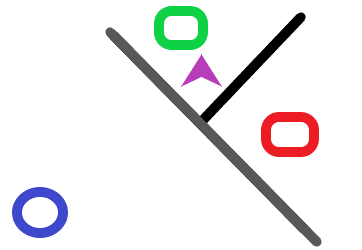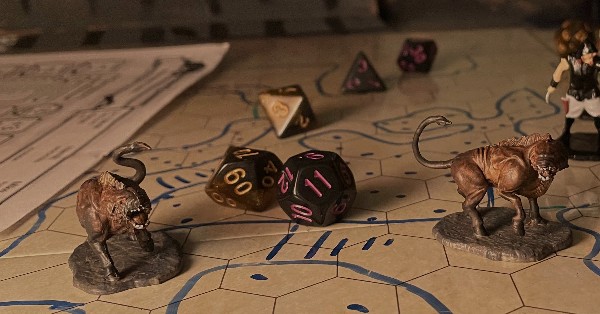Each object in a 20-foot cube within range is outlined in blue, green, or violet light (your choice). Any creature in the area when the spell is cast is also outlined in light if it fails a Dexterity saving throw. For the duration, objects and affected creatures shed dim light in a 10-foot radius.
Any attack roll against an affected creature or object has advantage if the attacker can see it, and the affected creature or object can’t benefit from being invisible.
Casting Time: 1 action
Range: 60 feet
Components: V
Duration: Concentration, up to 1 minute
School: 1st-level evocation
Player’s Handbook, pg. 239
Faerie Fire 5e
Faerie Fire has changed a lot since DnD’s first edition, but it’s still an iconic spell that lights everything and everybody in range up with color auras. Here we’ll cover frequently-asked about rules as well as the best situations and ways to use Faerie Fire.
Who Can Cast Faerie Fire in 5e?
The following classes have Faerie Fire on their spell list:
-
Bard
-
Druid
-
Artificer (TCoE 12)
The following subclasses get Faerie Fire for free:
-
Cleric (Light Domain)
-
Warlock (The Archfey)
-
Cleric (Twilight Domain) (TCoE 34)
-
Ranger (Swampkeeper) (TCoE 60)
What Does Faerie Fire Do in 5e?
Faerie Fire instantly illuminates each object in a 20-foot cube in a color of your choice and forces each creature (friend, foe, and yourself included) in the cube to make a Dexterity saving throw. On a fail, the creature is also illuminated, and any attack against it has advantage.
All objects and affected creatures shed dim light in a 10-foot radius. This negates invisibility and makes it impossible for an affected creature to become invisible.
What Are the Rules for Faerie Fire in 5e?
The rules for Faerie Fire in DnD 5e are as follows:
-
The Darkness spell dispels Faerie Fire. Faerie Fire is a 1st-level magical light-producing spell; Darkness is a 2nd-level magical darkness-producing spell that dispels magical light created by spell of 2nd-level or lower. If a creature is in Darkness, Faerie Fire won’t affect them, and if they’re already affected by Faerie Fire and move into the radius of Darkness, Faerie Fire will be dispelled.
This has been confirmed by Jeremy Crawford.
-
Upcasting Faerie Fire can beat Darkness. The exact ruling isn’t 100% clear here, and we don’t have Jeremy for this one. However, RAI seems to indicate that a Faerie Fire cast using a 3rd-level spell slot or higher should penetrate the Darkness spell, if targets within the darkness fail their saving throw.
However, the Darkness spell has a 15-foot radius, so a creature standing in the middle of it and giving off dim light in a 10-foot radius would still be heavily obscured to anyone looking at the sphere of Darkness. Faerie Fire also doesn’t dispel the Darkness effect the way that the Daylight spell does. Darkness itself can also be upcast to beat an upcast Faerie Fire.
Other than that, it’s up to your DM to decide how the two spells interact.
-
Invisible creatures are illuminated and everyone had advantage on attack rolls against them. Some players may think that the disadvantage of attacking an invisible target and the advantage of attacking a creature affected by Faerie Fire balance out to no advantage or disadvantage.
However, because Faerie Fire cancels the effect of invisibility, everyone just has straight-up advantage on the now visible, Faerie Fire’d target. Again, confirmed by Jeremy Crawford.
This might imply that you’d also gain advantage against an enemy in Darkness that you’ve beaten with an upcast Faerie Fire instead of the two effects canceling each other out. Plus, Faerie Fire’s description does state the attacker gets advantage on attack rolls “if that attacker can see [the target],” which in this case seems true.
-
Faerie Fire only forces one save, then lasts the duration. One great thing about Faerie Fire is that there’s only one saving throw involved. If the target fails that and you can maintain concentration, you’ll have advantage attacking them for a full 10 rounds.
-
Faerie Fire affects friends, foes, and yourself. Faerie Fire forces all creatures within a 20-foot cube to make a Dexterity saving throw, including you and your party. If an enemy attacks an affected creature, they will have advantage on their attack roll.
-
Faerie Fire is a glitter bomb. Faerie Fire affects creatures and objects in the 20-foot cube, but it’s not a static thing. An affected creature or object that leaves that 20-foot cube is still under the effect of Faerie Fire.
From the spell text (emphasis mine): “any creature in the area when the spell is cast is also outlined in light…For the duration.”
This also means that a creature that enters the 20-foot cube after the initial casting doesn’t have to make a Dexterity saving throw or be affected, and objects brought into the cube don’t suddenly become outlined with light.
-
Creatures do not get a bonus to their Dexterity saving throw with cover. As the rules state, “a target with total cover can’t be targeted directly by an attack or a spell, althought some spells can reach such a target by including it in an area of effect” (PHB 196).
However, the rules on areas of effect also state that “if no unblocked straight line extends from the point of origin to a location within the area of effect, that location isn’t included in the spell’s area. To block one of these imaginary lines, an obstruction must provide total cover” (PHB 204).
So if the point of origin can’t “see” the creature, it won’t affect the creature. If the point of origin can “see” the creature, it will force a save and possibly affect the creature. Hopefully, this crude picture can help:
The blue circle is the caster, the purple triangle is the point of origin for Faerie Fire. The green target is hit because the point of origin can “see” him. The red target is not affected, because the black wall provides total cover from the spell’s point of origin.
Since spells like Fireball explicitly mention wrapping around corners, we can also reason out that Faerie Fire doesn’t wrap around corners.
How Do I Use Faerie Fire in 5e?
Here are some of the best ways to optimize Faerie Fire, as well as some alternative uses you can employ:
-
Use it on high AC, low Dex targets. To get the best bang for your buck, bring out Faerie Fire when you’re dealing with a target that’s more likely to fail (thanks to low Dexterity) and who you’ll benefit from gaining advantage against most (thanks to high AC).
While a creature’s stat block is not something most players (or DMs) memorize, you can use your intuition. Heavily armored humanoids, Iron/Stone Golems, and Helmed Horrors come to mind as juicy targets.
Blue, Red, and White Dragons also have especially bad Dexterity modifiers (+0), making Faerie Fire much more likely to land on them. That’s a huge boost to your party’s damage over the course of combat.
-
Set your martial class allies up. Barbarians, Fighters, Rangers, Rogues, and Paladins are all going to have a lot of fun annihilating whatever creatures you light up with Faerie Fire. Rogues especially are going to enjoy the guaranteed Sneak Attack.
Just be careful not to bathe an ally in the fire of faeries, or they’ll likely become the target of enemies attacks’. While a high Dexterity Rogue or Fighter might make the saving the throw, that bulky plate-wearing Paladin’s probably getting lit it up. Which brings us to our next point…
-
Giving a tank aggro. Sometimes, it actually pays to Faerie Fire a friend purposefully. Dumb and smart enemies alike will naturally be attracted to a target they have advantage against. If your tank is okay with it, this can be a really effective way of keeping foes focused on the ones you want them to be focused on.
-
Finding and eliminating invisible enemies. One of Faerie Fire’s greatest uses is dealing with invisible targets — especially annoying at low levels. But it’s equally great for dealing with foes who are otherwise obscured, like a Bugbear you might think be hiding behind a pillar up ahead, or a Lizard Folk Shaman obscured by her Fog Cloud.
-
Low range dim light on your whole party. 10 feet of dim light is a nice small number that’s hard to find elsewhere in the game. It’s enough to see where you’re going without alerting far-off foes. The great thing is that if combat does break out, you can always just cancel your concentration on the spell and get rid of that pesky advantage you’d be giving enemies.
Faerie Fire’s also a fun spell to flavor. The colors they give as examples don’t really matter — you can use whatever color you feel goes with your character’s vibe. Or you could change it from fire entirely.
Maybe phosphorescent mushrooms rapidly bloom on affected targets, or musical notes dance around them.
Is Faerie Fire 5e a Good Spell?
Yes, Faerie Fire is a great spell that scales incredibly well. Faerie Fire impacts a huge area (a 4×4 square on battle maps) and grants attack advantage against affected creatures for 10 rounds of combat, if you can maintain concentration. It only has one saving throw, which means if it lands, it sticks — incredibly powerful for such a huge party-wide damage boost.
Granting martials, and especially Rogues, attack advantage provides more raw damage than most first-level spells are capable of. It fits perfectly with support/utility builds that want to help other players shine, and you’ll be a party favorite if you make it a staple of your combat strategy.
Faerie Fire 5e DM Tips
Faerie Fire is a fairly straightforward spell to DM. Just remember that it’s a “glitter bomb” effect, meaning affected objects and creatures stay affected for the full duration, even if they leave the initial area where the spell was cast.
The other important thing to remember (and remind players about) is that Faerie Fire also affects friendly creatures.
Other than that, reward players who make creative use of the spell and encourage flavorful descriptions of the spell’s visible effects.
Faerie Fire FAQ
-
Does Faerie Fire let you see invisible creatures?
Faerie Fire cancels the effect of invisibility, allowing everyone to see and have advantage on attack rolls against the now visible target.
-
What is the use of Faerie Fire?
Faerie Fire illuminates objects and creatures in a 20-foot cube, granting advantage on attack rolls against affected creatures and negating invisibility.
-
Does Faerie Fire work in the Ethereal Plane?
Faerie Fire affects creatures and objects in the designated area, regardless of the plane they are on, including the Ethereal Plane.
-
Does Faerie Fire work against Mirror Image?
Faerie Fire does not directly affect the Mirror Image spell. However, if the original caster of Mirror Image is affected by Faerie Fire, the duplicates created by Mirror Image would also be affected and become illuminated.


![Fire Bolt 5e [DnD Spell Guide: Uses, Rules, Tips] dnd-blue-dragon-vs-party-minis](https://www.dndlounge.com/wp-content/uploads/2022/03/dnd-blue-dragon-vs-party-minis-300x203.jpg)
![Fire Spells 5e [DnD] IMG_3795](https://www.dndlounge.com/wp-content/uploads/2023/04/IMG_3795-300x169.webp)
![Sword Burst 5e [DnD Spell Guide: Uses, Rules, Tips] dungeons-and-dragons-orc-miniatures](https://www.dndlounge.com/wp-content/uploads/2022/03/dungeons-and-dragons-orc-miniatures-300x180.jpg)
![Fly 5e [DnD Spell Guide, Tips, Rules, Uses] misty-step-5e](https://www.dndlounge.com/wp-content/uploads/2022/03/misty-step-5e-300x161.jpg)